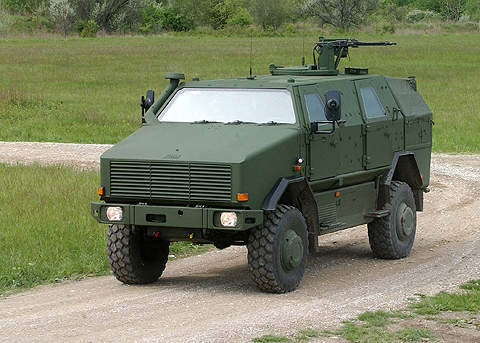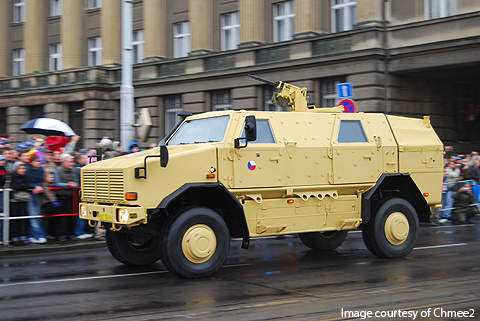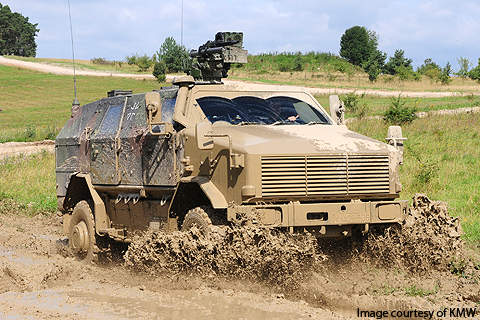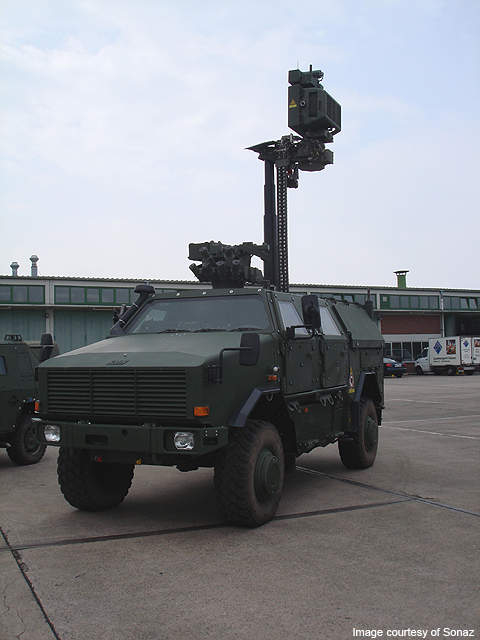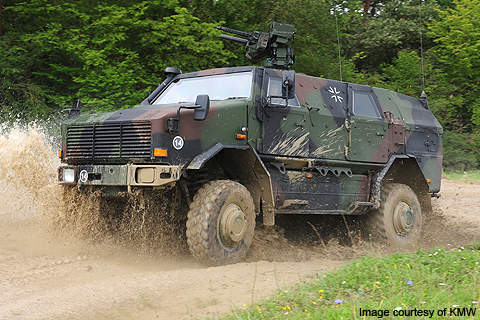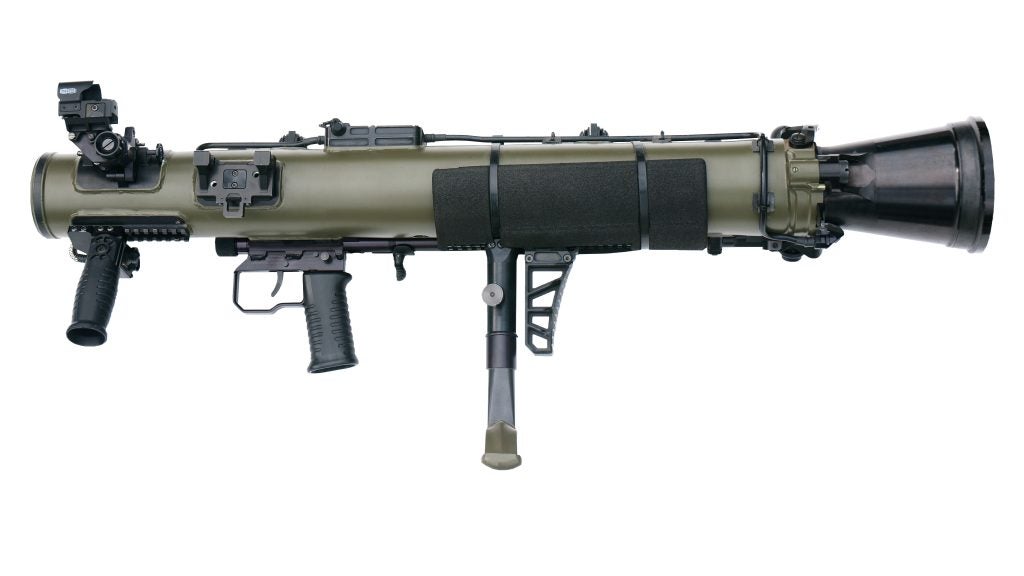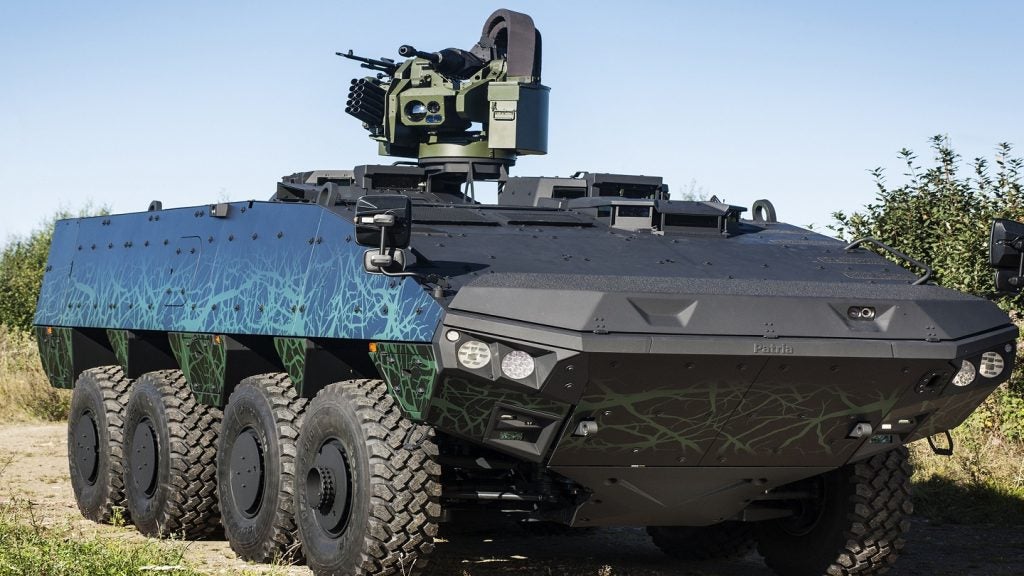
The Dingo 2 all-protected carrier vehicle (APCV /APV)
Dingo 2 is an all-protected carrier vehicle (APCV or APV) manufactured by Germany-based Krauss-Maffei Wegmann (KMW). The vehicle features first-class protection, high tactical mobility, mission specific variants and a broad range of equipment options. It offers the best protective equipment available in its class for international missions. The vehicle can accommodate a crew of eight.
Dingo 2 was first introduced in 2003 as a demonstrator. Three vehicles were developed initially: two long (3.85m) wheel base (LWB) vehicles and one with a short (3.25m) wheel base (SWB). The development of the LWB vehicles was funded by Germany and the SWP development for presentations was funded by KMW. The two LWB vehicles underwent trials between November 2003 and May 2004. After six months of trials, the vehicle was accepted for entry into service in 2004. The vehicle finally entered into service in late 2004.
The APV was tested in various overseas missions in countries including Bosnia, Afghanistan, Kosovo and Lebanon. As of November 2010, the vehicle is in use in Germany, Belgium, Austria, Luxembourg, Norway and the Czech Republic. In Germany, the Federal Office of Defence Technology and Procurement (BWB) is the government branch that deals with the orders of the vehicle.
The Dingo APV is named after the native Australian dog, the Dingo. The long and short wheel base vehicles have payload capacities of 3.5t and 4t respectively.
Dingo 2 APV design
Dingo 2 is an upgraded version of Dingo 1, an APV developed by KMW that has been in use since 2001. The upgrades include a different chassis and increased payload among others.
Dingo 2 has been developed with a modular design and comes with a 4×4 configuration. The main emphasis during the development of Dingo 2 has been laid on the protection of the crew. The resultant modular structure of the vehicle has helped it stand up to the operational realities of constantly growing and changing threats. The vehicle has steel alloy armour.
Dingo 2 features a Mercedes-Benz Unimog 5000 chassis, which is produced by Daimler AG (formerly DaimlerChrysler).
The vehicle offers integral collective NBC protection, air-conditioning and GPS navigation. Other integral systems available include rear-view camera, anti-lock braking system (ABS), and radio and internal communications systems.
Dingo 2 orders and deliveries
In early 2004, BWB ordered the first batch of 52 Dingo 2 APVs for delivery in late 2004. In September 2004, Austria placed an order for 20 vehicles for delivery through late 2004 to 2005. In 2005, Belgium placed an order for 220 Dingo 2 vehicles, with an option for another 132 units. One vehicle was delivered in late 2005 and the remaining units have been slated for delivery between 2006 and 2011.
BWB ordered another 149 Dingo 2 vehicles in 2006, in a contract worth €109m. Of the 149 units, 15 were delivered in 2006 and the rest in 2007. The Czech Republic ordered four Dingo 2 units in 2007. Luxembourg ordered 48 vehicles in 2008. In July 2008, the German Army placed an order for 54 vehicles, with option for an additional 44 units.
BWB placed an order in March 2010 for 41 Dingo 2 vehicles. In April 2010, BWB ordered 44 Dingo 2 GSI mobile workshop vehicles from KMW. The vehicles were delivered to the German Army by end of 2010. These vehicles are deployed in Afghanistan.
In October 2010, the Norwegian Army ordered 20 Dingo 2 vehicles for its troops operating in the Hindu Kush Mountains in Afghanistan. The first ten vehicles were delivered in November 2010 while the rest were delivered in February 2011.
In April 2011, BWB placed an order for the assembly and delivery of 39 Dingo 2 GE variants. Deliveries are scheduled to conclude by November 2011.
A total of 240 Dingo 2 vehicles will be delivered to the German Army throughout 2011. KMW has orders for over 800 Dingo 2 vehicles from five different nations.
Dingo 2 operators include Austria (20), Belgium (220 and 132 options), Germany (a total of 593 vehicles planned before 2013), Czech Republic (19), Norway (20 including ten on order) and Luxembourg (48).
Dingo 2 mission variants
The Dingo 2 GSI (battle damage repair) vehicle has a payload of up to 2t and is used for logistics and deployments. The mobile workshop variant provides cabin space for three personnel and an integrated storage system. The vehicle is also equipped with its own generator to produce electricity.
The Dingo 2 ground surveillance vehicle (BÜR) features a radar system with the same safety and mobility features as that of its parent. Dingo 2 pickup is a mobile logistics variant. It is heavily protected and features a payload of up to 3t.
The Dingo 2 ambulance and emergency vehicle is used for treatment and transportation of contaminated personnel. It features state-of-the-art emergency equipment and ergonomic accommodation for three to four personnel.
The Dingo 2 NBC reconnaissance vehicle is a variant used to detect nuclear and chemical warfare agents. It features state-of-the-art sensors and equipment for reconnaissance.
A Dingo 2 variant for use in civilian and support roles is also available, and can be deployed in high-threat regions. Other variants include the Dingo 2 police vehicle.
Armament
The FLW 100 light weapons station, a lightweight remotely controlled weapons station, is mounted on the Dingo 2. The primary armament of the weapon station is the Rheinmetall MG3 machine gun turret. In place of the 7.62mm MG, a 12.7mm MG or an HK GMG automatic grenade launcher can be installed in the station. The armament is remotely controlled by the operator from inside the vehicle.
The gyro stabilisation of the weapon system allows the utmost precision and control, even while driving fast through a difficult terrain.
Defence and self-protection
Dingo 2 is protected against small arms and artillery shrapnel. Protection against anti-personnel and anti-tank mines is also provided. The vehicle features a mine-proof seat system that prevents the transfer of explosion energy to the crew. Furthermore, the vehicle offers protection against improvised explosive devices (IEDs) and against NBC (nuclear, biological and chemical) warfare agents.
Engine
The Dingo 2 APVC is powered by a single Daimler AG Mercedes-Benz Euro 3 six-cylinder liquid-cooled diesel engine. The power of the engine is 163kW.
Mobility
Dingo 2 can reach a maximum speed of 90km/h and has cruise range of over 1,000km. The vehicle can be air transported and deployed by various aircraft including the C-160, C-130 Hercules and Airbus A400M. The vehicle can produce brilliant performance, even in extremely difficult terrains and under extreme climatic conditions. The high tactical mobility and ease of transfer of the vehicle are the reasons for its deployment in several countries.
Contractors
The main contractor for manufacturing the vehicle is Krauss-Maffei Wegmann. The sub-contractors are Daimler AG and European Aeronautic Defence and Space Co (EADS) NV.


